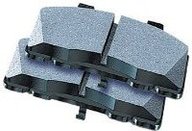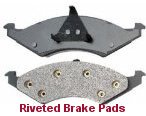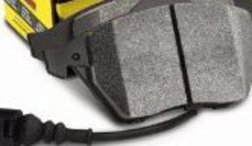
This disc brake pads page is an overview of one of the most common maintenance operations performed on the automobile, regardless of what year they built it.
The reason why this service is performed so often is that the main component, the brake pad, is designed to wear out. Brake pads are metal plates with the friction linings either riveted or bonded to them. It’s nice to know which ones you have, because this can help decide when too replace them for maintenance reasons.
A bonded pad can wear down much closer to the backing plate than a riveted one. If you let a riveted friction lining go too long before replacing it, the rivets can dig into the rotor and this could cost you more money and complicate the otherwise simple repairs.

Also if your vehicle is equipped with a bonded pad you want to make sure you replace them with the same design replacement parts. Identifying which ones are on your vehicle is important.
If you look at the face of the friction material and it is solid all the way across (pictured above) it should be a bonded type. If it has holes in the face then it most likely is a riveted type like the one pictured on the right.

On some luxury vehicles especially fancy German ones like BMW and Mercedes, sometimes the pads will have a built in electrical sensor embedded in the friction material.
In this case you will have to buy replacement parts with these sensors to maintain the design and features of the vehicle. The sensor becomes grounded against the rotor when the pads are worn through. This turns a handy warning light on in the dash that says please check the brake wear or something similar.
Disc Brake Pad Maintenance
The friction linings are placed at each side of the caliper and straddle the disc brake rotor. On most vehicles the inner brake pad which is positioned against the caliper piston is not interchangeable with the outer one. The reason is, that some brake pads have wear sensing indicators and anti rattle clips.
The two most common design wear sensors are an audible type which can be heard when driving and the visual type which can be seen on inspection of the brakes. The audible wear sensors are thin spring steel tabs that are riveted to the back of the pad itself and are bent to contact the rotor when the lining wears down to a specific point.
When touching the sensor causes a high pitched squeal when the wheel is turning. This noise can often go away when the brakes are applied. The audible noise gives a warning to the driver that service is needed and could possibly save the rotors from damage. When you are replacing friction linings these wear indicators usually go towards the rear of the caliper so they make the most noise going forward.
How Long Will Brakes Last
As mentioned above the most common operation when it comes to braking system repairs would be replacement of the friction material. Lot’s of people ask how long will brakes last.
This is a hard question to answer, but I’ll supply a general rule of thumb you can follow. Most front brakes will last between 25,000 35,000 miles on average. Many factors are involved in the actual miles you will get out of yours.
One of these variables is the style of driving. People that put mostly highway miles on their vehicle and experience little stop and go traffic like, rural Texas driving, can get much more miles out of a set of pads. Under these kind of driving conditions it’s not unusual to go 50 or 60,000 miles before regular scheduled maintenance is required.
On the other side of the equation would be city driving with lots of stop and go traffic jam type situations. As you can imagine this isn’t good for the longevity of the friction material.
Using the common example of a city cab, it is not unusual for these types of heavy-duty fleet vehicles to require pad replacement in as little as 15,000 miles or less. How long will brakes last?
Finally the type of braking that the primary drivers perform most often will have a huge impact on the pad life and therefore the needed maintenance intervals. If you are a 2 foot driver or drive very aggressively with extremely hard braking you will find that you will need to perform maintenance more often. Give this all about disc brake pads page a share or bookmark.
If you need a set of rotors with the pad replacement (recommended) here is a list of the Best selling brake rotors on Amazon.
I have built a repair module that talks about most of the major components of the car disc brake system. This next link takes you to the start page from this page about disc brake pads.
Need tips on how to check your disc brake pads to see if they require replacement? I have a page about how to perform brake pad inspections.

